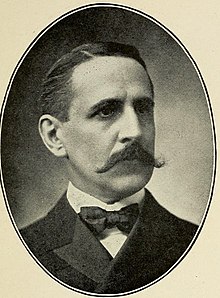James A. Tawney
James Albertus Tawney | |
|---|---|
 | |
| Member of the U.S. House of Representatives from Minnesota's 1st district | |
| In office March 4, 1893 – March 3, 1911 | |
| Preceded by | William H. Harries |
| Succeeded by | Sydney Anderson |
| House Majority Whip | |
| In office March 4, 1899 – March 3, 1905 | |
| Preceded by | Position established |
| Succeeded by | James E. Watson |
| Member of the Minnesota Senate | |
| In office 1890 | |
| Personal details | |
| Born | James Albertus Tawney January 3, 1855 Mount Pleasant Township, Pennsylvania, U.S. |
| Died | June 12, 1919 (aged 64) Excelsior Springs, Missouri |
| Political party | Republican |
| Spouse | Emma B. Newall |
| Children | 5 |
| Alma mater | University of Wisconsin–Madison |
James Albertus Tawney (January 3, 1855 – June 12, 1919) was an American blacksmith, machinist and U.S. politician and a member of the United States House of Representatives from Minnesota. He was the first House Majority Whip, holding that position from 1899 to 1905.
Early life
[edit]Tawney was born in Mount Pleasant Township, near Gettysburg, Adams County, Pennsylvania. He apprenticed with his father as a blacksmith, and subsequently learned the trade of machinist. In 1877, he moved to Winona, Minnesota, where he was employed as a blacksmith and machinist until 1881. He attended the law department of the University of Wisconsin–Madison "having previously devoted mornings and evenings to the study of law for about two years," and was admitted to the bar in 1882 and commenced practice in Winona.[1]
Political career
[edit]Tawney was elected to the Minnesota Senate in 1890. In 1892, he was elected to Congress as a Republican, and served in the 53rd, 54th, 55th, 56th, 57th, 58th, 59th, 60th, and 61st congresses.[1] During his time in Congress, Tawney served as Majority Whip and as chairman of the House Committee on Appropriations.
In 1910 he was defeated in the Republican primary by 30-year-old Sydney Anderson, who had the support of Theodore Roosevelt, Gifford Pinchot and other Progressive Republicans. Anderson ran on a platform of drastically reduced tariffs and opposition to Cannonism (with which Tawney was identified).
After Congress
[edit]Tawney was a member of the International Joint Commission (created to prevent disputes regarding the use of Boundary Waters between the United States and Canada) from 1911 until his death, serving as chairman of the United States section from September 17, 1911, to December 1, 1914.
Tawney died at Excelsior Springs, Clay County, Missouri.
References
[edit]- ^ a b "S. Doc. 58-1 - Fifty-eighth Congress. (Extraordinary session -- beginning November 9, 1903.) Official Congressional Directory for the use of the United States Congress. Compiled under the direction of the Joint Committee on Printing by A.J. Halford. Special edition. Corrections made to November 5, 1903". GovInfo.gov. U.S. Government Printing Office. 9 November 1903. p. 56. Retrieved 2 July 2023.
- United States Congress. "James A. Tawney (id: T000060)". Biographical Directory of the United States Congress.
- 1855 births
- 1919 deaths
- American blacksmiths
- Machinists
- Republican Party members of the Minnesota House of Representatives
- Republican Party Minnesota state senators
- University of Wisconsin–Madison alumni
- University of Wisconsin Law School alumni
- Republican Party members of the United States House of Representatives from Minnesota
- 19th-century American legislators
- People from Gettysburg, Pennsylvania
- People from Winona, Minnesota
- 19th-century Minnesota politicians
- Minnesota politician stubs


